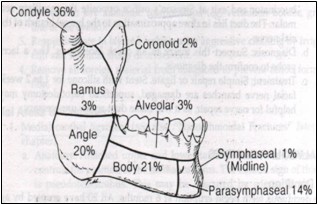

Mandibular fractures can be predicted with adequate preoperative planning for each case and identify the related risk factors for this complication. The parameters that most frequently characterise mandibular fractures at the mandibular angle are deeply impacted lower third molars, Class II and III, B and C, according to the Pell & Gregory classification system, mesioangular according to the Winter's classification, and are located on the left mandibular side. Postoperative mandibular fractures after 3MI occur more frequently in male patients between the ages of 40 and 60 and are caused by premature chewing force.

The exclusion criteria were nonhuman studies and case reports. The inclusion criteria were articles including at least 10 patients and were published in English in the last 10 years.

The aim of this systematic review is to report the prevalence of mandibular fractures that occur intra- and postoperatively in patients who have undergone surgical removal of the lower third molar.Īn electronic database search for articles published in Cochrane, PubMed (MEDLINE) and Scopus was conducted using the key words "Molar, Third" "Mandibular Fractures" "Molar Third, Removal" "Molar Third, Complications" "Dental Extractions, Complications" "Mandibular Fractures, Third molar removal". The surgical extraction of the lower third molars is one of the most common procedures in oral surgery, and this surgical operation can cause intra- and postoperative complications such as pain, trismus, bleeding, infection, oedema, inferior alveolar nerve injuries, displacement of teeth to neighbouring spaces and mandibular fractures. The panoramic X-Rays showed us the bone fracture healing. On the follow-up, the patient showed an improvement in mouth opening and mandibular mobility without pain or infection signs. The patient underwent surgery under general anesthesia to open reduction with internal fixation (ORIF) through an intraoral approach. In the assessment, the patient presented edema, pain, malocclusion, and restriction in mandible mobility, and the panoramic X-ray showed a mandible fracture with displacement. A 27-year-old female was referred to the oral and maxillofacial surgery service of the Santa Casa Hospital of Araçatuba (Araçatuba, Brazil), reporting dental history of third molar removal, with immediately chief complaints. Thus this study aims to report a case about a mandible fracture after third molar extraction, presenting edema, pain, and restriction in mandible mobility in 01-day follow-up. Surgical planning as the indication to the surgery has to be performed to avoid complications as the fracture. Fractures caused by a third molar can occur, and on the other hand, the fractures after or during the management of impacted third molar are a possible complication. Surgical management of impacted third molars is a treatment performed by dentists and its indicated for various conditions, among the indications has the prevention of mandibular fracture, but this is a factor that has been discussed and is controversial.


 0 kommentar(er)
0 kommentar(er)
